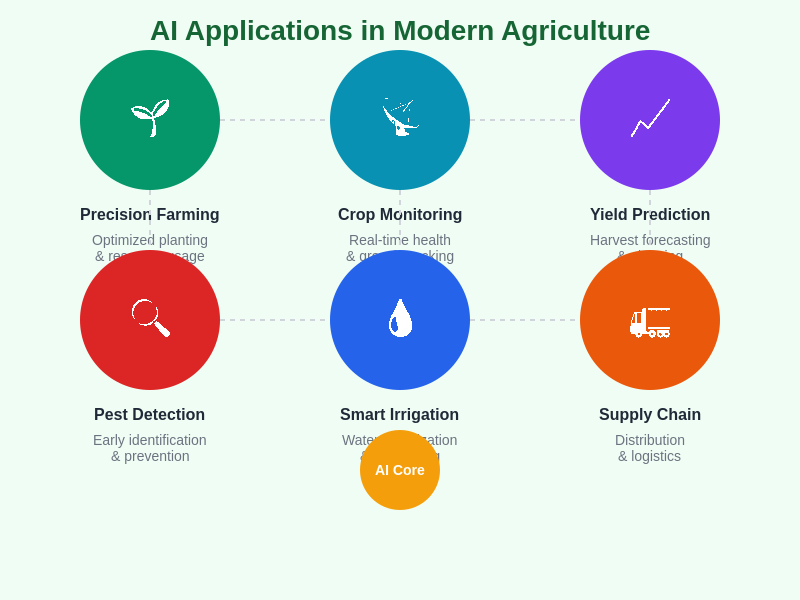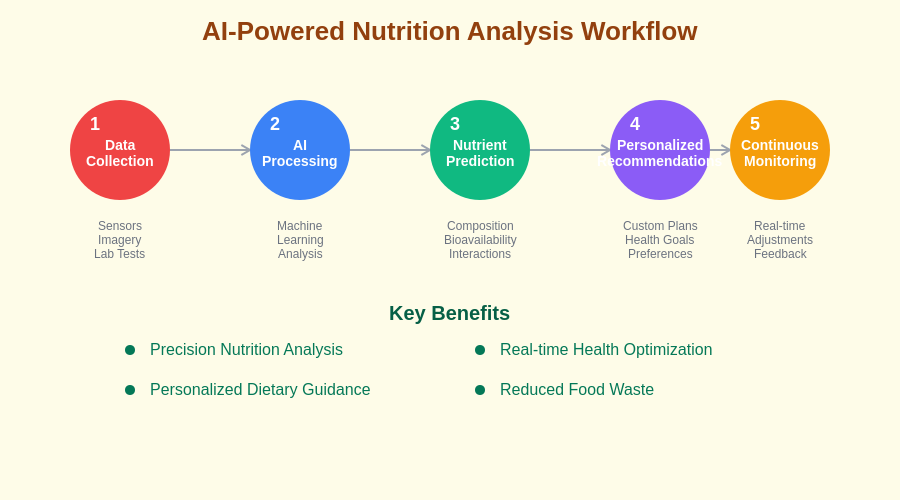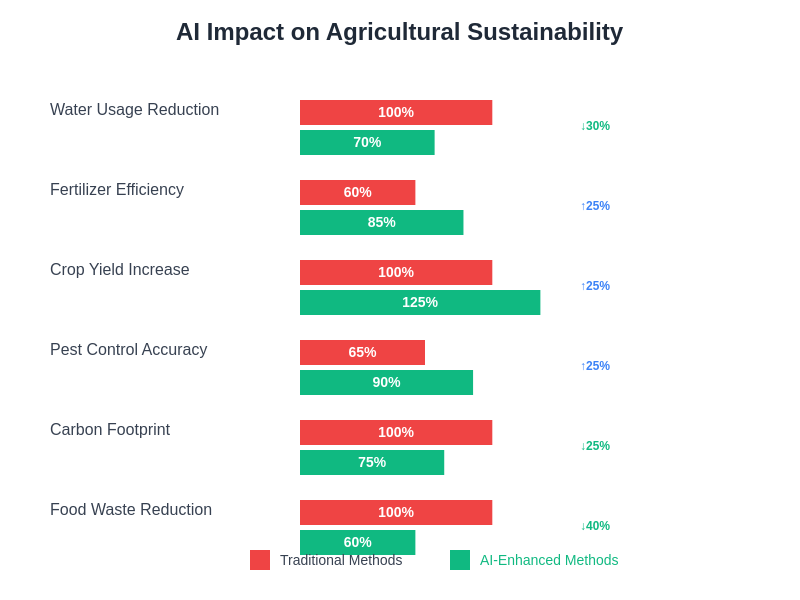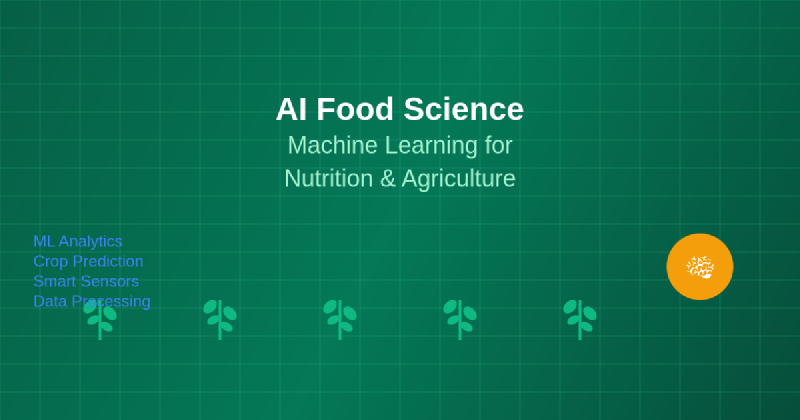The intersection of artificial intelligence and food science represents one of the most promising frontiers in addressing humanity’s most fundamental needs. As global populations continue to expand and climate challenges intensify, machine learning technologies are emerging as transformative tools that promise to revolutionize how we produce, analyze, distribute, and consume food. This convergence of cutting-edge technology with agricultural wisdom and nutritional science is creating unprecedented opportunities to enhance food security, optimize nutritional outcomes, and develop sustainable farming practices that can feed the world while preserving our planet’s precious resources.
Explore the latest AI innovations in food technology to stay current with breakthrough developments that are reshaping the entire food ecosystem. The application of artificial intelligence to food science extends far beyond simple automation, encompassing sophisticated analytical capabilities that can predict crop yields, optimize nutritional compositions, detect food safety issues, and personalize dietary recommendations with unprecedented precision and scale.
The Revolutionary Impact of AI on Modern Agriculture
The agricultural sector has embraced artificial intelligence as a cornerstone technology for addressing the complex challenges of modern farming. Machine learning algorithms are now capable of analyzing vast datasets encompassing soil conditions, weather patterns, crop genetics, and historical yield data to provide farmers with actionable insights that dramatically improve both productivity and sustainability. These intelligent systems can predict optimal planting times, recommend precise fertilizer applications, and identify potential pest infestations before they become widespread problems, enabling proactive rather than reactive farming strategies.
Precision agriculture represents perhaps the most visible application of AI in food production, where sophisticated sensors, drones, and satellite imagery work in concert with machine learning models to create detailed maps of farmland conditions. These technologies enable farmers to apply water, nutrients, and pesticides with surgical precision, reducing waste while maximizing crop yields. The environmental benefits of this approach are substantial, as targeted applications significantly reduce the ecological impact of agricultural chemicals while maintaining or improving production levels.
The integration of AI-powered robotics in farming operations has further revolutionized agricultural practices, with autonomous tractors, harvesting machines, and planting systems capable of operating with minimal human supervision. These robotic systems utilize computer vision and machine learning to navigate fields, identify individual plants, and perform delicate operations such as selective harvesting or weed removal with accuracy that often exceeds human capabilities.

The comprehensive ecosystem of AI applications in agriculture demonstrates the interconnected nature of modern smart farming technologies, where each component contributes to an integrated system that optimizes every aspect of food production from initial planning through final harvest and distribution.
Advanced Crop Monitoring and Predictive Analytics
Modern agricultural AI systems have evolved to provide comprehensive crop monitoring capabilities that extend throughout the entire growing season. Machine learning algorithms analyze multispectral satellite imagery, drone-captured photographs, and ground-based sensor data to assess plant health, estimate biomass, and predict harvest timing with remarkable accuracy. These systems can detect subtle changes in vegetation indices that indicate stress conditions, nutrient deficiencies, or disease onset days or weeks before symptoms become visible to the human eye.
Predictive analytics in agriculture leverages historical data, current conditions, and sophisticated modeling techniques to forecast everything from yield expectations to market prices. These predictions enable farmers to make informed decisions about crop selection, resource allocation, and marketing strategies, ultimately improving profitability while reducing risks associated with weather variability and market fluctuations. The accuracy of these predictions continues to improve as machine learning models incorporate larger datasets and more sophisticated algorithms.
Discover how AI assistants like Claude can help analyze agricultural data and provide insights for optimizing farming operations through advanced reasoning and data interpretation capabilities. The combination of real-time data collection and predictive modeling creates a powerful foundation for evidence-based agricultural decision-making that maximizes both economic and environmental outcomes.
Transforming Nutritional Analysis and Food Safety
The application of machine learning to nutritional analysis has opened new possibilities for understanding the complex relationships between food composition, processing methods, and human health outcomes. AI systems can now analyze the molecular composition of foods with unprecedented detail, identifying bioactive compounds, predicting nutritional interactions, and assessing the bioavailability of essential nutrients under various conditions. This level of analysis was previously impossible or extremely time-consuming using traditional laboratory methods.
Food safety has been dramatically enhanced through AI-powered monitoring systems that can detect contamination, spoilage, and quality degradation in real-time throughout the supply chain. Machine learning algorithms analyze data from sensors that monitor temperature, humidity, pH levels, and microbial activity to predict food safety risks and optimize storage conditions. These systems can identify potential problems before they result in foodborne illnesses or product recalls, protecting both consumer health and industry reputation.
Computer vision applications in food processing facilities utilize sophisticated image recognition algorithms to inspect products for defects, foreign objects, and quality inconsistencies at speeds far exceeding human capabilities. These automated inspection systems ensure consistent product quality while reducing labor costs and improving food safety outcomes across the entire production process.
Personalized Nutrition and Dietary Optimization
The emergence of personalized nutrition represents a paradigm shift from one-size-fits-all dietary recommendations to individualized nutritional guidance based on genetic profiles, metabolic characteristics, and lifestyle factors. Machine learning algorithms analyze complex datasets that include genomic information, biomarker levels, activity patterns, and dietary preferences to create customized nutrition plans that optimize health outcomes for each individual. This personalized approach recognizes that nutritional needs vary significantly between individuals and that optimal dietary strategies must account for these differences.
AI-powered nutrition applications can track food intake, analyze nutritional content, and provide real-time feedback on dietary choices, helping individuals make informed decisions about their nutrition throughout the day. These systems learn from user behavior and preferences to provide increasingly accurate and relevant recommendations that align with personal health goals and dietary constraints.
The integration of wearable devices and continuous health monitoring technologies with AI nutrition platforms creates comprehensive health optimization systems that can adjust dietary recommendations based on real-time physiological data, exercise patterns, sleep quality, and stress levels. This dynamic approach to nutrition ensures that dietary guidance remains relevant and effective as individual circumstances and health status evolve over time.

The sophisticated workflow of AI-powered nutrition analysis demonstrates how multiple data sources and advanced algorithms converge to create personalized dietary recommendations that adapt continuously to individual needs and preferences while maintaining optimal health outcomes.
Supply Chain Optimization and Food Distribution
Artificial intelligence has revolutionized food supply chain management by providing sophisticated tools for optimizing logistics, reducing waste, and ensuring product quality throughout the distribution process. Machine learning algorithms analyze demand patterns, transportation networks, and storage capabilities to optimize routing decisions, minimize transportation costs, and reduce delivery times. These optimization systems can dynamically adjust to changing conditions such as weather events, transportation disruptions, or unexpected demand fluctuations.
Inventory management has been transformed through AI systems that can predict demand with high accuracy, optimize stock levels, and coordinate purchasing decisions across complex supply networks. These systems reduce food waste by ensuring that perishable products move through the supply chain efficiently while maintaining optimal freshness and quality. The economic and environmental benefits of reduced food waste are substantial, as food production represents one of the largest consumers of natural resources globally.
Cold chain monitoring represents a critical application of AI in food distribution, where machine learning systems continuously analyze temperature data, predict equipment failures, and optimize energy consumption in refrigerated storage and transportation systems. These intelligent monitoring systems ensure that temperature-sensitive products maintain their quality and safety throughout the distribution process while minimizing energy costs and environmental impact.
Enhance your research capabilities with Perplexity to access comprehensive information about emerging technologies in food science and agricultural innovation. The rapid pace of technological advancement in this field requires continuous learning and adaptation to leverage new opportunities and address evolving challenges.
Sustainable Farming Practices and Environmental Impact
The environmental sustainability of agricultural practices has become a central focus of AI applications in food science, with machine learning systems designed to optimize resource utilization while minimizing ecological impact. These systems analyze soil health indicators, water availability, carbon sequestration potential, and biodiversity metrics to recommend farming practices that balance productivity with environmental stewardship. The integration of sustainability metrics into agricultural decision-making represents a fundamental shift toward more responsible food production methods.
Water management has been revolutionized through AI systems that optimize irrigation scheduling based on soil moisture levels, weather forecasts, and crop water requirements. These intelligent irrigation systems can reduce water consumption by up to 30% while maintaining or improving crop yields, addressing one of the most pressing resource challenges facing modern agriculture. The precision with which these systems can deliver water to crops minimizes runoff and reduces the risk of nutrient leaching into groundwater systems.
Carbon footprint optimization represents an emerging application of AI in agriculture, where machine learning algorithms analyze the carbon intensity of various farming practices and recommend strategies for reducing greenhouse gas emissions while maintaining productivity. These systems consider factors such as tillage practices, fertilizer applications, livestock management, and transportation logistics to identify opportunities for carbon reduction throughout the agricultural value chain.

The measurable improvements in sustainability metrics achieved through AI implementation demonstrate the technology’s potential to address environmental challenges while maintaining or improving agricultural productivity, creating a foundation for truly sustainable food production systems.
Food Product Development and Innovation
The food industry has embraced artificial intelligence as a powerful tool for accelerating product development and creating innovative food solutions that meet evolving consumer preferences and nutritional requirements. Machine learning algorithms can analyze flavor profiles, texture characteristics, and nutritional compositions to predict consumer acceptance of new products and optimize formulations for specific target markets. This data-driven approach to product development reduces the time and cost associated with traditional trial-and-error methods while increasing the likelihood of commercial success.
Flavor prediction and optimization represent sophisticated applications of AI in food science, where machine learning models analyze molecular structures, sensory data, and consumer preferences to predict taste profiles and identify optimal ingredient combinations. These systems can suggest novel flavor combinations, predict how processing conditions will affect taste and aroma, and optimize recipes to achieve specific sensory targets while maintaining nutritional and economic constraints.
Alternative protein development has been significantly accelerated through AI applications that can analyze protein structures, predict functional properties, and optimize processing conditions for plant-based and cultivated meat products. Machine learning algorithms help identify promising protein sources, optimize extraction and purification processes, and design products that closely mimic the sensory characteristics of traditional animal proteins while offering improved sustainability profiles.
Quality Control and Food Authentication
The implementation of AI-powered quality control systems has transformed food processing operations by providing continuous monitoring capabilities that ensure consistent product quality and safety. Machine learning algorithms analyze data from multiple sensors including spectroscopic devices, imaging systems, and chemical analyzers to detect quality deviations in real-time. These systems can identify subtle changes in product characteristics that might indicate contamination, adulteration, or processing errors before they affect large production batches.
Food authentication has become increasingly important as global supply chains grow more complex and food fraud becomes more sophisticated. AI systems utilize advanced analytical techniques including spectroscopy, chromatography, and isotope analysis combined with machine learning algorithms to verify product authenticity, detect adulteration, and ensure compliance with labeling requirements. These authentication systems can identify counterfeit products, verify geographical origins, and confirm organic or specialty certifications with high accuracy.
Traceability systems powered by artificial intelligence create comprehensive records of food products from farm to consumer, enabling rapid response to safety issues and providing transparency that increasingly conscious consumers demand. These systems can track individual products or batches throughout the supply chain, recording processing conditions, storage environments, and handling procedures to ensure accountability and facilitate rapid recalls when necessary.
Precision Livestock Management
Animal agriculture has been transformed through AI applications that monitor individual animal health, optimize feeding programs, and improve overall livestock welfare while enhancing productivity. Machine learning systems analyze behavioral patterns, physiological indicators, and environmental conditions to detect health issues early, predict optimal breeding times, and customize management strategies for individual animals. These precision livestock management systems improve animal welfare while optimizing production efficiency and reducing resource consumption.
Automated feeding systems utilize AI algorithms to optimize nutrition delivery based on individual animal requirements, growth stages, and production goals. These systems can adjust feed compositions in real-time based on milk production data, weight gain patterns, and health status indicators, ensuring that each animal receives optimal nutrition while minimizing feed waste and environmental impact.
Disease prevention and early detection represent critical applications of AI in livestock management, where machine learning algorithms analyze multiple data streams including behavior patterns, body temperature, feed consumption, and movement patterns to identify animals that may be developing health issues. Early detection enables prompt intervention that can prevent disease spread and reduce the need for antibiotic treatments, contributing to more sustainable and responsible animal agriculture practices.
Future Innovations and Emerging Technologies
The future of AI in food science promises even more sophisticated applications as emerging technologies such as quantum computing, advanced robotics, and biotechnology converge with machine learning capabilities. Quantum computing applications may enable complex molecular simulations that could revolutionize our understanding of nutritional interactions and enable the design of foods with precisely tailored health benefits. Advanced robotics will continue to automate physical tasks throughout the food system while providing increasingly sophisticated sensing and manipulation capabilities.
Biotechnology integration with AI systems will likely enable the development of engineered crops with enhanced nutritional profiles, improved stress tolerance, and optimized resource utilization characteristics. Machine learning algorithms will play crucial roles in designing these enhanced crops by predicting the effects of genetic modifications and optimizing breeding programs for complex trait combinations.
Cellular agriculture represents an emerging field where AI will play a central role in optimizing cultivation conditions for lab-grown meat and other cellular food products. Machine learning systems will be essential for controlling the complex bioreactors used in cellular agriculture, optimizing growth media compositions, and ensuring consistent product quality in this revolutionary approach to food production.
The integration of AI with emerging sensing technologies will create even more sophisticated monitoring and control systems throughout the food ecosystem. Advanced sensors capable of detecting molecular-level changes, combined with AI algorithms that can interpret complex data patterns, will enable unprecedented levels of precision in food production, processing, and quality control.
Global Food Security and Accessibility
Artificial intelligence applications in food science hold tremendous promise for addressing global food security challenges by optimizing production efficiency, reducing waste, and improving access to nutritious foods in underserved regions. Machine learning systems can help optimize crop selection for specific climatic conditions, predict and mitigate the impacts of extreme weather events, and develop resilient food systems that can adapt to changing environmental conditions.
Digital agriculture platforms powered by AI can democratize access to agricultural expertise by providing small-scale farmers with sophisticated tools and knowledge that were previously available only to large agricultural operations. Mobile applications utilizing machine learning can provide crop management guidance, market price information, and technical support to farmers in developing regions, potentially transforming agricultural productivity and rural livelihoods.
The optimization of global food distribution networks through AI systems could significantly reduce food waste and improve access to fresh, nutritious foods in food-insecure regions. Machine learning algorithms can optimize transportation routes, predict demand patterns, and coordinate relief efforts to ensure that food resources are distributed efficiently and effectively where they are needed most.
The continued advancement of AI technologies in food science represents one of humanity’s best opportunities to create a sustainable, equitable, and nutritious food system that can meet the needs of a growing global population while preserving environmental resources for future generations. The convergence of artificial intelligence with agricultural science, nutrition research, and food technology creates unprecedented possibilities for innovation and positive impact on human health and planetary sustainability.
Disclaimer
This article is for informational purposes only and does not constitute professional advice. The views expressed are based on current understanding of AI technologies and their applications in food science and agriculture. Readers should conduct their own research and consult with relevant experts when implementing AI-powered solutions in agricultural or food science applications. The effectiveness and safety of AI technologies may vary depending on specific use cases, regulatory requirements, and implementation contexts.
